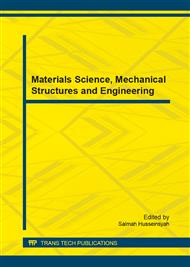[1]
N.A. Cytovicha: Osnovanija i fundamenty (uchebnik). Moskva. (1959). 374 p.
Google Scholar
[2]
B.I. Dalmatov. K voprosu o raschete peschanyh podushek / Osnovanija, fundamenty i mehanika gruntov. Moskva. 4 (1963), pp.12-15.
Google Scholar
[3]
SP 22. 13330. 2011. Osnovanija zdanij i sooruzhenij. Aktualizi-rovannaja redakcija SNiP 2. 02. 01-83*. Moskva. (2011).
Google Scholar
[4]
M. P. Bolshtjanskij: Jeksperimental'noe issledovanie naprjazhenij v neodnorodnoj sypuchej srede. Osnovanija, fundamenty i mehanika gruntov. Moskva. № 6. (1962). pp.11-13.
Google Scholar
[5]
A.K. Birjulja. Mehanicheskie svojstva sloev uplotnennogo grunta i ih issledovanie v mnogoslojnyh dorozhnyh odezhdah. Sbornik trudov HADI. Har'kov, №30, (1963), pp.56-59.
Google Scholar
[6]
V. N. Lukant'eva, A. O. Sall: Tehnicheskij tekstil,. Nauchno-tehnicheskij zhurnal. Moskva. №9, (2004). pp.16-25.
Google Scholar
[7]
V. A. Il'icheva, R. A. Mangusheva: Proektirovanie i ustrojstvo osnovanij, armirovannyh geosinteticheskimi materialami. Spravochnik geotehnika. Osnovanija, fundamenty i podzemnye sooruzhenija. Moskva. (2014) 728 p.
Google Scholar
[8]
N.I. Vatin, A.S. Gorshkov, D.V. Nemova: Energy efficiency of envelopes at major repairs, Construction of Unique Buildings and Structures, 3 (8) (2013), pp.1-11.
Google Scholar
[9]
A. Gorshkov, N. Vatin, D. Nemova: The energy saving formula, Energy efficiency of envelopes at major repairs, Construction of Unique Buildings and Structures, 7 (12) (2013), pp.49-63.
Google Scholar
[10]
M.A. Platonova, N.I. Vatin, D.V. Nemova, S.A. Matoshkina, D. Iotti, I. Togo: The influence of the airproof composition on the thermo technical characteristics of the enclosing structures, Construction of Unique Buildings and Structures, 4 (19) (2014).
Google Scholar
[11]
A.S. Gorshkov, N.I. Vatin, T.A. Datsyuk, A. Yu. Bezrukov, D.V. Nemova, P. Kakula, A. Viitanen: Album of technical solutions for the application of polyurethane foam thermal insulation products in construction of residential, public and industrial buildings. ATP - STC - 02 - 14: materials for design, Construction of Unique Buildings and Structures, 5 (20) (2014).
Google Scholar
[12]
V. Murgul: Features of energy efficient upgrade of historic buildings (illustrated with the example of Saint-Petersburg). Journal of Applied Engineering Science, Vol. 12 (1) (2014), pp.1-10.
DOI: 10.5937/jaes12-5609
Google Scholar
[13]
V. Murgul: Solar energy systems in the reconstruction of heritage historical buildings of the northern towns (for example Sankt-Petersburg). Journal of Applied Engineering Science, Vol. 12 (2) (2014), pp.121-128.
DOI: 10.5937/jaes12-6136
Google Scholar
[14]
D. Vuksanovic, V. Murgul, N. Vatin: Shadowing impact on amount of power generated by photovoltaic modules. Applied Mechanics and Materials. Vols. 587-589 (2014), pp.342-347.
DOI: 10.4028/www.scientific.net/amm.587-589.342
Google Scholar
[15]
R. Alihodzic, V. Murgul, N. Vatin, E. Aronova, V. Nikolić, M. Tanić, D. Stanković: Renewable Energy Sources used to Supply Pre-school Facilities with Energy in Different Weather Conditions. Applied Mechanics and Materials Vol. 624 (2014).
DOI: 10.4028/www.scientific.net/amm.624.604
Google Scholar
[16]
G. Radovic, V. Murgul, N. Vatin, E. Aronova. Hybrid photovoltaic-diesel energy system optimization (case study of electric power supply for buildings under the weather conditions of Montenegro). Applied Mechanics and Materials. Vol. 627 (2014).
DOI: 10.4028/www.scientific.net/amm.627.357
Google Scholar
[17]
V. Murgul: Improvement of the energy efficient properties of the houses in the historical area of Saint-Petersburg, Architecton: Proceedings of Higher Education, 4 (40) (2012), pp.54-62.
Google Scholar
[18]
D. Nemova, V. Murgul, A. Golik, E. Chizhov, V. Pukhkal, N. Vatin: Reconstruction of administrative buildings of the 70s: the possibility of energy modernization. Journal of Applied Engineering Science, Vol. 12 (1), (2014), pp.37-44.
DOI: 10.5937/jaes12-5610
Google Scholar
[19]
GrinfeldI G., Gorshkov A., Vatin N. (2014). Tests results strength and thermophysical properties of aerated concrete block wall samples with the use of polyurethane adhesive. Advanced Materials Research. Vols. 941-944. pp.786-799.
DOI: 10.4028/www.scientific.net/amr.941-944.786
Google Scholar
[20]
A. S. Gorshkov, N. I. Vatin, A. I. Urustimov, P. P. Rymkevich: Computational justification for engineering measures preventing the ice dams formation on the pitched roofs, Magazine of Civil Engineering. 3 (29) (2012), pp.69-73.
DOI: 10.5862/mce.29.9
Google Scholar
[21]
A. S. Gorshkov, P. P. Rymkevich, D. V. Nemova, N. I. Vatin: Method of calculating the payback period of investment for renovation of building facades. Construction of Unique Buildings and Structures. 2 (17). (2014), pp.82-106.
Google Scholar
[22]
N. I. Vatin, D. V. Nemova. Increase of power efficiency of buildings of kindergartens. Construction of Unique Buildings and Structures. 3 (2012), pp.52-76.
Google Scholar
[23]
M. A. Platonova, N. I. Vatin, D. V. Nemova, S. A. Matoshkina, D. Iotti, I. Togo: The influence of the airproof composition on the thermo technical characteristics of the enclosing structures, Construction of Unique Buildings and Structures, 4 (19) (2014).
Google Scholar
[24]
R.A. Mangushev, R.A. Usmanov: Iskusstvennye osnovanija s ustrojstvom vysokouplotnennyh podushek na slabyh vodonasyshhennyh lessovyh gruntah. Osnovanija, fundamenty i mehanika gruntov. Moskva. №2, (2009), pp.6-11.
Google Scholar


